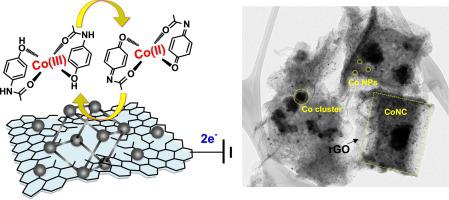当前位置:
X-MOL 学术
›
Chem. Eng. J.
›
论文详情
Our official English website, www.x-mol.net, welcomes your
feedback! (Note: you will need to create a separate account there.)
Cobalt and zinc imidazolate encapsulated in reduced graphene oxide and the derived nitrogen-enriched carbon frameworks (CoNC@rGO) for electrochemically sensing acetaminophen (APAP)
Chemical Engineering Journal ( IF 13.3 ) Pub Date : 2023-12-30 , DOI: 10.1016/j.cej.2023.148437
Yu-Jen Shih , Sheng-Kai Lin , Zhi-Lun Wu , Wei-Hsiang Chen
Chemical Engineering Journal ( IF 13.3 ) Pub Date : 2023-12-30 , DOI: 10.1016/j.cej.2023.148437
Yu-Jen Shih , Sheng-Kai Lin , Zhi-Lun Wu , Wei-Hsiang Chen

|
Electrochemical detection of the analgesic acetaminophen (APAP) was carried out using a composite of cobalt and zinc imidazolate frameworks and graphene oxie (Co/ZnZIF@GO). Co/ZnZIF@GO was thermally reduced to create cobalt/nitrogen-enriched carbon and reduced graphene oxide (CoNC@rGO), which greatly facilitated the current response for APAP sensing. The mesoporosity of NC cubes embedded in rGO sheets and the dispersity of Co nanoparticles were manipulated by the carbonization temperature. Electroanalysis and Raman spectra revealed that the reversible conversion of phenolic hydroxyl to ketone in the doubly chelated APAP on surface Co sites accounted for the faradaic current of APAP oxidation. CoNC@rGO(800), synthesized at 800 °C under a N2 atmosphere, with an optimal metal ratio of Co0.5 Zn0.5 and 50 % GO loading maximized electrode sensitivity. This resulted in a high sensitivity (0.598 μA μM−1 ) and a low detection limit (0.067 μM) in the range of 0.5–50 μM. Through the differential pulse voltammetry technique (DPV), the synthesized sensor exhibited excellent reproducibility, selectivity, and recovery for detecting APAP in various real-world water samples.
中文翻译:

封装在还原氧化石墨烯和衍生的富氮碳骨架 (CoNC@rGO) 中的咪唑钴和咪唑锌,用于电化学传感对乙酰氨基酚 (APAP)
使用咪唑钴锌框架和氧化石墨烯 (Co/ZnZIF@GO) 的复合材料对镇痛剂对乙酰氨基酚 (APAP) 进行电化学检测。 Co/ZnZIF@GO经过热还原生成富钴/氮的碳和还原氧化石墨烯(CoNC@rGO),这极大地促进了APAP传感的电流响应。嵌入 rGO 片材中的 NC 立方体的介孔率和 Co 纳米颗粒的分散度由碳化温度控制。电分析和拉曼光谱表明,表面Co位点上的双螯合APAP中酚羟基向酮的可逆转化是APAP氧化的法拉第电流的原因。 CoNC@rGO(800),在 N2 气氛下于 800 °C 下合成,具有最佳金属比例 Co0.5Zn0.5 和 50% GO 负载量,可最大化电极灵敏度。这导致了高灵敏度 (0.598 μA μM−1) 和 0.5–50 μM 范围内的低检测限 (0.067 μM)。通过差分脉冲伏安技术(DPV),合成的传感器在检测各种实际水样中的 APAP 时表现出优异的重现性、选择性和回收率。
更新日期:2023-12-30
中文翻译:

封装在还原氧化石墨烯和衍生的富氮碳骨架 (CoNC@rGO) 中的咪唑钴和咪唑锌,用于电化学传感对乙酰氨基酚 (APAP)
使用咪唑钴锌框架和氧化石墨烯 (Co/ZnZIF@GO) 的复合材料对镇痛剂对乙酰氨基酚 (APAP) 进行电化学检测。 Co/ZnZIF@GO经过热还原生成富钴/氮的碳和还原氧化石墨烯(CoNC@rGO),这极大地促进了APAP传感的电流响应。嵌入 rGO 片材中的 NC 立方体的介孔率和 Co 纳米颗粒的分散度由碳化温度控制。电分析和拉曼光谱表明,表面Co位点上的双螯合APAP中酚羟基向酮的可逆转化是APAP氧化的法拉第电流的原因。 CoNC@rGO(800),在 N2 气氛下于 800 °C 下合成,具有最佳金属比例 Co0.5Zn0.5 和 50% GO 负载量,可最大化电极灵敏度。这导致了高灵敏度 (0.598 μA μM−1) 和 0.5–50 μM 范围内的低检测限 (0.067 μM)。通过差分脉冲伏安技术(DPV),合成的传感器在检测各种实际水样中的 APAP 时表现出优异的重现性、选择性和回收率。































 京公网安备 11010802027423号
京公网安备 11010802027423号